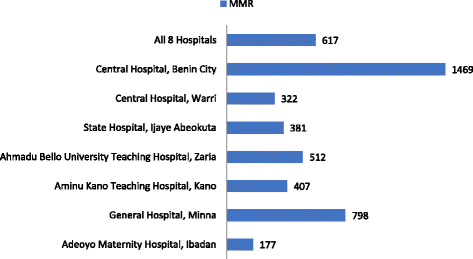Association of the client-provider ratio with the risk of maternal mortality in referral hospitals: a multi-site study in Nigeria
- PMID: 29471845
- PMCID: PMC5824472
- DOI: 10.1186/s12978-018-0464-0
Association of the client-provider ratio with the risk of maternal mortality in referral hospitals: a multi-site study in Nigeria
Abstract
Background: The paucity of human resources for health buoyed by excessive workloads has been identified as being responsible for poor quality obstetric care, which leads to high maternal mortality in Nigeria. While there is anecdotal and qualitative research to support this observation, limited quantitative studies have been conducted to test the association between the number and density of human resources and risk of maternal mortality. This study aims to investigate the association between client-provider ratios for antenatal and delivery care and the risk of maternal mortality in 8 referral hospitals in Nigeria.
Methods: Client-provider ratios were calculated for antenatal and delivery care attendees during a 3-year period (2011-2013). The maternal mortality ratio (MMR) was calculated per 100,000 live births for the hospitals, while unadjusted Poisson regression analysis was used to examine the association between the number of maternal deaths and density of healthcare providers.
Results: A total of 334,425 antenatal care attendees and 26,479 births were recorded during this period. The client-provider ratio in the maternity department for antenatal care attendees was 1343:1 for doctors and 222:1 for midwives. The ratio of births to one doctor in the maternity department was 106:1 and 18:1 for midwives. On average, there were 441 births per specialist obstetrician. The results of the regression analysis showed a significant negative association between the number of maternal deaths and client-provider ratios in all categories.
Conclusion: We conclude that the maternal mortality ratios in Nigeria's referral hospitals are worsened by high client-provider ratios, with few providers attending a large number of pregnant women. Efforts to improve the density and quality of maternal healthcare providers, especially at the first referral level, would be a critical intervention for reducing the currently high rate of maternal mortality in Nigeria.
Trial registration: Trial Registration Number: NCTR91540209 . Nigeria Clinical Trials Registry. Registered 14 April 2016.
Keywords: Client-provider ratio; Maternal mortality; Nigeria; Referral hospitals.
Conflict of interest statement
Ethics approval and consent to participate
Ethical approval for the study was obtained from the World Health Organization and the National Health Research Ethics Committee (NHREC) of Nigeria – number NHREC/01/01/2007–16/07/2014, renewed in 2015 with NHREC 01/01/20047–12/12/2015b. The Chief Medical Directors and Heads of Departments of the hospitals were informed of the purpose of the study, and consent was obtained from all participants to conduct the study. Participants were assured that the information obtained would be confidential. Only the hospitals that agreed to participate in the fully explained study were enlisted in the study. No names or specific contact information were obtained from the study participants.
Consent for publication
All of the authors gave their consent for this publication.
Competing interests
The authors declare that they have no competing interests.
Publisher’s Note
Springer Nature remains neutral with regard to jurisdictional claims in published maps and institutional affiliations.
Figures
Similar articles
-
Outcome of multifaceted interventions for improving the quality of antenatal care in Nigerian referral hospitals.Reprod Health. 2020 Nov 4;17(1):170. doi: 10.1186/s12978-020-00997-6. Reprod Health. 2020. PMID: 33148284 Free PMC article.
-
Effect on mortality of community-based maternity-care programme in rural Bangladesh.Lancet. 1991 Nov 9;338(8776):1183-6. doi: 10.1016/0140-6736(91)92041-y. Lancet. 1991. PMID: 1682600 Clinical Trial.
-
Qualitative assessment of women's satisfaction with maternal health care in referral hospitals in Nigeria.Reprod Health. 2017 Mar 16;14(1):44. doi: 10.1186/s12978-017-0305-6. Reprod Health. 2017. PMID: 28302182 Free PMC article.
-
Organizing delivery care: what works for safe motherhood?Bull World Health Organ. 1999;77(5):399-406. Bull World Health Organ. 1999. PMID: 10361757 Free PMC article. Review.
-
Reduction of maternal and perinatal mortality in rural and peri-urban settings: what works?Eur J Obstet Gynecol Reprod Biol. 1996 Oct;69(1):47-53. doi: 10.1016/0301-2115(95)02535-9. Eur J Obstet Gynecol Reprod Biol. 1996. PMID: 8909956 Review.
Cited by
-
Outcome of multifaceted interventions for improving the quality of antenatal care in Nigerian referral hospitals.Reprod Health. 2020 Nov 4;17(1):170. doi: 10.1186/s12978-020-00997-6. Reprod Health. 2020. PMID: 33148284 Free PMC article.
-
Metrics for maternity unit staffing in low resource settings: Scoping review and proposed core indicator.Front Glob Womens Health. 2023 Mar 15;4:1028273. doi: 10.3389/fgwh.2023.1028273. eCollection 2023. Front Glob Womens Health. 2023. PMID: 37009093 Free PMC article.
-
Antenatal Clinic Waiting Time, Patient Satisfaction, and Preference for Staggered Appointment-A Cross-Sectional Study.J Patient Exp. 2021 Nov 25;8:23743735211060802. doi: 10.1177/23743735211060802. eCollection 2021. J Patient Exp. 2021. PMID: 34869846 Free PMC article.
-
A Strategy for Reducing Maternal Mortality in Rural Kenya.Int J Womens Health. 2023 Apr 3;15:487-498. doi: 10.2147/IJWH.S396257. eCollection 2023. Int J Womens Health. 2023. PMID: 37033121 Free PMC article.
-
Attitude of postpartum women towards multiple postnatal clinic schedule in south-west Nigeria.Eur J Obstet Gynecol Reprod Biol X. 2023 May 16;18:100197. doi: 10.1016/j.eurox.2023.100197. eCollection 2023 Jun. Eur J Obstet Gynecol Reprod Biol X. 2023. PMID: 37273910 Free PMC article.
References
-
- Alkema L, Zhang S, Chou D, Gemmill A, Moller A-B, Fat DM, et al. A Bayesian approach to the global estimation of maternal mortality. ArXiv151103330 Stat [Internet]. 2015 Nov 10 [cited 2016 Aug 15]; Available from: http://arxiv.org/abs/1511.03330.
-
- World Health Organization. WHO | Trends in maternal mortality: 1990 to 2015 [Internet]. WHO. 2015 [cited 2017 Jul 29]. Available from: http://www.who.int/reproductivehealth/publications/monitoring/maternal-m....
-
- Bauserman M, Lokangaka A, Thorsten V, Tshefu A, Goudar SS, Esamai F, et al. Risk factors for maternal death and trends in maternal mortality in low- and middle-income countries: a prospective longitudinal cohort analysis. Reprod Health. 2015;12(Suppl 2):S5. doi: 10.1186/1742-4755-12-S2-S5. - DOI - PMC - PubMed
Publication types
MeSH terms
Grants and funding
LinkOut - more resources
Full Text Sources
Other Literature Sources
Medical
Miscellaneous


